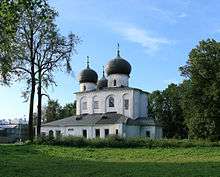Antoniev Monastery
The Antoniev Monastery ("St Anthony's Monastery", Russian: Антониев монастырь) rivalled the Yuriev Monastery as the most important monastery of medieval Novgorod the Great. It stands along the right bank of the Volkhov River north of the city centre and forms part of the Historic Monuments of Novgorod and Surroundings, a World Heritage Site.

The monastery was founded in 1117 by St Anthony of Rome (Antony Rimlyanin), who, according to legend, flew to Novgorod from Rome on a rock (the alleged rock is now in the vestibule just to the right of the main door into the Church of the Nativity of the Mother of God beneath a fresco of Bishop Nikita of Novgorod). Antonii was consecrated hegumen of the monastery in 1131 by Archbishop Nifont (1130–1156) and was buried beneath a large slab to the right of the altar in the same church.
The Church of the Nativity of the Mother of God, like the Church of St. George in the Yuriev Monastery, is one of the few three-domed churches in Russia. It is also one of the few buildings in Russia which survived from the 12th century. It was founded by Antonii in 1117 and completed in 1119. There are some frescoes from the Middle Ages still extant, most notably in the apse, but most are from the sixteenth or seventeenth centuries and are in some disrepair.
The monastery is currently part of the Novgorod United Museum-Preserve and has not been returned to the Russian Orthodox Church.
| Wikimedia Commons has media related to Antoniev Monastery. |
See also
- Desyatinny Monastery
References
- Robert Michell and Neville Forbes, ed., The Chronicle of Novgorod, 1016-1471 (New York: American Medieval Society Press, 1970), 9-10, 12.